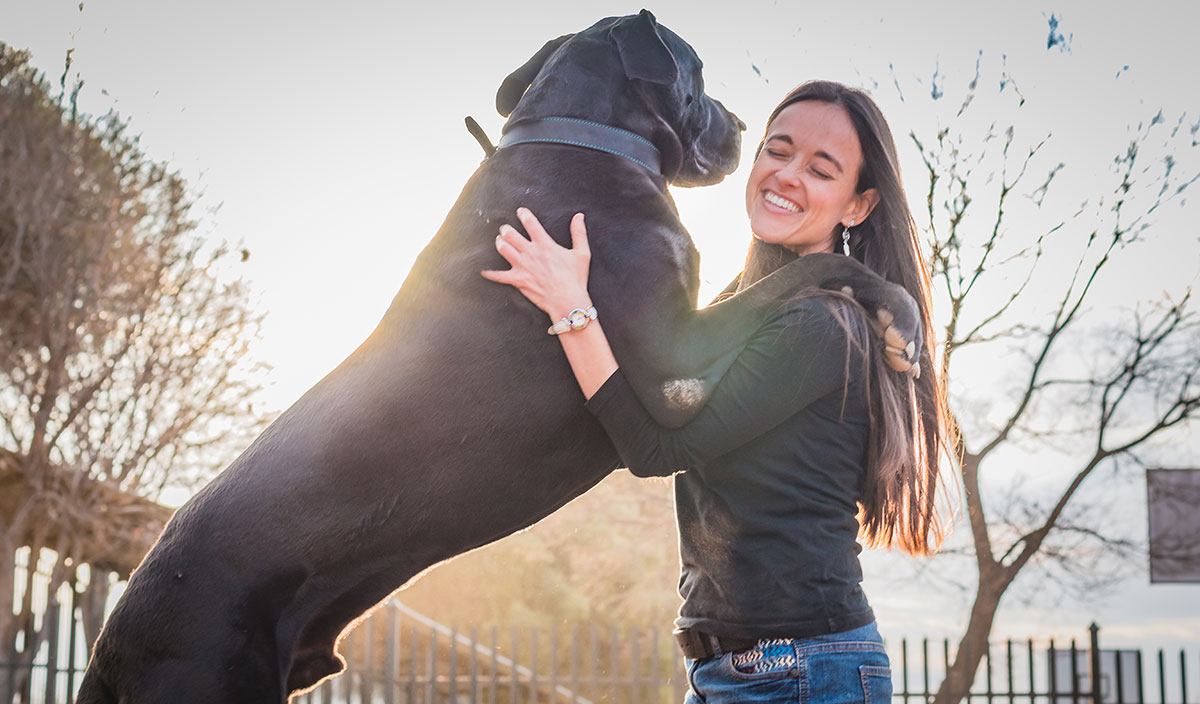
Great Dane: Giant German Dog Breed

The Great Dane Is not Called Great For nothing!
| Name | Great Dane - Working |
|---|---|
| Size | Large |
| Grooming | Easy Enough |
| Training | Moderate |
| Exercise | Lots 2 hours + a day |
| Origins | Germany |
The Great Dane: The Apollo Of The Dog World
Do you have a big house, a big car and a decent size yard or garden? If not then read on for fun but don't even think about getting a Great Dane. If however, you are fortunate enough to have ticked all the boxes and you want a big (and we mean really big) pet dog who is as loving and gentle as they are huge then go for it.
Ok, pre-filtering aside what has a Great Dane got going for it? Well for a start they’re one of the best-natured dogs around who love attention, playing and children. Once they were warrior dogs bred to hunt Wild Boar, but that trait has been long since bred out of them making them the gentle giants of the dog world.
They need surprisingly little grooming and don't really drool, are friendly towards other dogs and strangers (although they would soon come to the defence of the family if they sensed threat). They are easy to train, generally healthy (but prone to weight gain so easy on the snacks) and don't have a high prey drive, meaning even the neighbourhood cats should be fairly safe.
Wow, they sound like the Heiniken of dogs (probably the best breed in the World) and for many they are, however like everything in life nothings perfect. The biggest downside is that they are sadly quite short-lived even for a large breed so be prepared for a bit of heartache. Also, they really do need a lot of attention and hate being alone. They thrive best in a family home where there is always someone around, and of course, a quick walk around the block exercise-wise is not going to cut it. They need lots of play and once their joints have firmed up (usually after 18 months) a bit of freedom to run around. Also they eat a lot so are not cheap to keep.
Still that's not too much to ask for all the love and affection you will get from one, so read on and learn a bit more about the Danish giant who is actually from Germany!
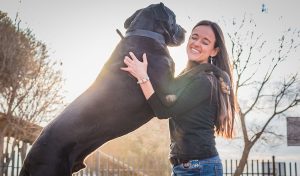
Image: Yuri Nunes/Shutterstock.com
Quick Overview
Name: Great Dane - Working Breed (UK Kennel Club)
Size: Typically 30 to 34 inches (76-86 cm) tall but the record is 44 inches from paw to shoulder!
Weight: 120-200 lbs 55-91 kg more than the average healthy person!
Grooming: Easy enough a good brushing regularly and an occasional bath.
Training: Easy enough at a basic level - use plenty of treats.
Exercise: Lots think a good hour plus a day walking and a run around in the garden as the minimum.
Temperament: Loyal and friendly love being around people.
Origins: German
Lifespan: 7-10 years is typical
They come in six different colours: Golden, Steel Blue (Think bluey-grey), Black, Harlequin & Mantle.
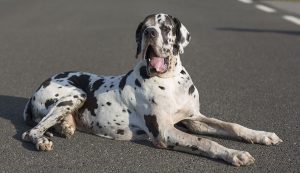
Image Roger costa morera/Shutterstock.com
Origins
Like most dog breeds, no one is completely certain of their historic roots, however, there is some reference to dogs which earned a resemblance dating back to ancient times with the oldest being drawings on Egyptian artefacts dating back to 3000 B.C. The breed which we know and love may have stemmed from them but it was refined in the late in the 1600s, when German nobles began keeping the largest and most handsome of their hunting dogs as family pets, calling them Kammerhunde (literally translated as Chamber Dogs). These early forerunners were rather pampered and perhaps that was the first step in changing their nature from fearsome hunters to the gentle giants they are today.
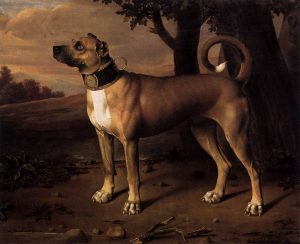
An early painting of a German Chamber Dog - You can see the resemblance.
Johann Christof Merck / Public domain
Selective breeding in Germany continued through the 1700s and by the early 1800s the breed was established as being different from the closely related English mastiff and in 1880 at a meeting in Berlin they were christened Deutsche Dogge (German Dog). However, for reasons unknown, it was decided to call them Great Danes, originally attributed to French naturalist, Georges-Louis Leclerc, Comte de Buffon who saw them while visiting Denmark calling them "le Grande Danois" (translated: Great Dane). And the rest, as they say, is history. But the late 19th Century they were internationally recognised and the Great Dane Club of America was formed in 1889 and they were soon recognised by the UK & American Kennel Club.
A Few Facts About The Great Dane!
- The record holder for the tallest dog so far was a Great Dane called Zeus who stood 111.8 cm (44.0 in) tall from paw to shoulder! Sadly he died in 2014 at the tender age of 5.
- Over In America, The Great Dane has been the State Dog of Pennsylvania since 1965.
- A Great Dane called Just Nuisance served in the Royal Navy from 1939 to 1944. When he died and was buried with full military honours.
- The cursed hellhound in both versions of Sir Arthur Conan Doyle's The Hound of the Baskervilles movie was a Great Dane.
- On a lighter note, the loveable cartoon character Scooby Doo is a Great Dane.
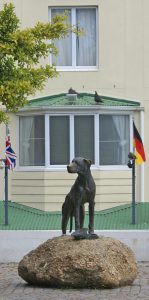
Statue of Just Nuisance Danie van der Merwe / Creative Commons Licence CC
How easy is it to train a Great Dane?
Very is the short answer. They are quite intelligent and are eager to please. However, given their size, it's important to begin training early and to ensure they are socialised as a big dog who takes no notice f you is going to be a problem. Inviting friends over when they are young will soon get them used to strangers and if you have other pets similar early introductions will keep things civil going forward. Fortunately, they are gentle by nature so even if you decide to opt for an older dog you shouldn't have too many issues. Always remember though that praise and the occasionally treat is the way to go with them.
How Much Grooming Does a Great Dane Need?
They shed a lot, but their coat is easy to keep clean with a good brushing 2-3 times a week. Use a firm bristle brush and a bit of dry shampoo as needed. This can help cut down on the need for Baths, which as you can imagine is no easy task given their size (and a nightmare if they don't want one!).
Nature and Temperament
Great Danes are especially fond of people, having come from the well pampered German Chamber Dogs. They're very gentle and affectionate pets who love to play and are relaxed with children. They have a great desire to please, which makes them easy to train.
The Great Dane wants to be where the family is. They like people a lot, including strangers and children, and will welcome visitors happily, unless they think you need defending. Then they can be fiercely protective.
Common Health Issues found in Great Danes
Due to their size, there are a number of issues that you need to be aware of:
- Gastric Torsion or Bloat: This is not a hereditary condition but is sadly life-threatening and one that large, deep-chested dogs such as Great Danes are especially prone to. It occurs when the stomach gets distended with gas and then gets twisted (hence gastric torsion). The main causes of this is eating a large meal too fast, exercising straight after eating and or drinking too much water after a meal. If it happens urgent veterinary attention would be needed so prevention is better than cure. So think smaller regular meals (at least two per day and preferably three) and an hours rest after eating. You may also want to restrict access to water during meal times.
- Heart disease in various guises is quite common. Regular check-ups at the Vet can spot issues as they arise and it can often be treated.
- Bone Cancer: Sometimes known as osteosarcoma. Large breeds such as the Great Dane can develop this at younger ages. The first sign is lameness, and if this occurs get the limb x-rayed asap.
- Hip Dysplasia: This is an inherited condition in which the thighbone doesn't fit snugly into the hip joint. This will be less of an issue if you buy from a reputable breeder as they will not breed from dogs already prone to it.
Don't fret too much on the above though as overall they are generally a healthy breed especially if bought from a reputable breeder.
Where to buy A Great Dane?
We recommend checking out your local dog shelters as sadly people still do buy puppies without checking the boxes first. Please make this your first port of call as dogs as loving as great Danes deserve caring and knowledgeable owners. If you have and can't find one or have your heart set on a puppy then get one from a kennel club registered breeder.
Five Minutes Spare
We have numerous other dog articles over on the Five Minutes Spare pages for those that love them as much as we do so please continue to browse or sign up to join our growing community.